History and Biblical SignificanceThessalonica was located at the intersection of two major Roman roads, one leading from Italy eastward (Ignatia Way) and the other from the Danube to the Aegean. Thessalonica’s location and use as a port made it a prominent city. In 168 B.C. it became the capital of the second district of Macedonia and later it was made the capital and major port of the whole Roman province of Macedonia (146 B.C.). In 42 B.C., after the battle at Philippi, Thessalonica was made a free city. Relatively little has been uncovered at ancient Thessalonica because Thessaloniki(the name for the modern city) sits atop the remains, but what has been uncovered is very interesting. |
Biblical SignificancePaul (with Silas and Timothy) came to Thessalonica from Philippi on his second missionary journey, stopping in Amphipolis and Apollonia before arriving here (Acts 17). He preached in the city’s synagogue, the chief synagogue of the region, for at least three weeks. His ministry was strong, and he established a Jewish-Gentile church, although it was more heavily Gentile (1 Thes. 1:9). When Paul faced great persecution at the hands of the mob, he fled to Berea, but Thessalonians eventually forced him to leave there also (Acts 17:13-14). An inscription (30 BC to 143 AD) from a gate in the Forum bears the word politarches, the word Luke used in reference to the officials of the city before whom Jason was brought by the mob (Acts 17:6). The word does not appear in any other Greek literature but does match the archaeology of the site. |
 The afternoon we landed in Thessalonica we had free time, so a few of us took a walk to see some of the sites. We first saw the Arch of Galerius on the main street Egnatia, which was also a Roman construction, known as Via Egnatia. The Arch of Galerius was built in 303 AD by Galerius, then Caesar of the East, to celebrate his victory over the Persians in 297 AD.
The afternoon we landed in Thessalonica we had free time, so a few of us took a walk to see some of the sites. We first saw the Arch of Galerius on the main street Egnatia, which was also a Roman construction, known as Via Egnatia. The Arch of Galerius was built in 303 AD by Galerius, then Caesar of the East, to celebrate his victory over the Persians in 297 AD.
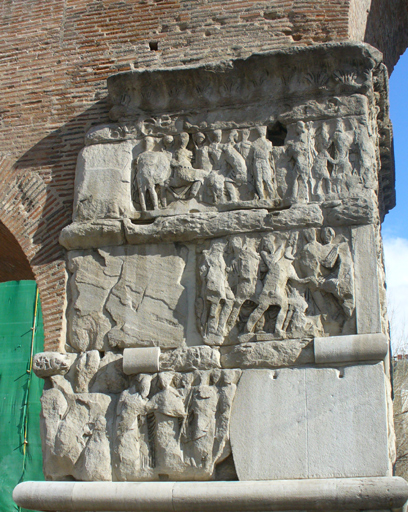 A closeup of some of the carving on the Arch.
A closeup of some of the carving on the Arch.
 Another panel, the center showing Galerius himself on horseback attacking the Persian commander.
Another panel, the center showing Galerius himself on horseback attacking the Persian commander.
 .
A section of the old city walls.
.
A section of the old city walls.
 Also nearby was the Rotunda of Galerius, built in 306 AD by Galerius, who was thought to have intended it to be his mausoleum. It was not used for that and stood empty until the Emperor Constantine I ordered it converted into a Christian church in the 4th century. The building functioned as a church for over 1,200 years until the city fell to the Ottomans. In 1590 it was then converted into the Mosque of Suleyman Hortaji Effendi, and a minaret was added to the structure. It remained a mosque until 1912, when the Greeks captured the city during the Balkan War. It was then formally re-consecrated into a church, but the minaret was not demolished. The structure was damaged during an earthquake in 1978 but was subsequently restored. The building is now a historical monument.
Also nearby was the Rotunda of Galerius, built in 306 AD by Galerius, who was thought to have intended it to be his mausoleum. It was not used for that and stood empty until the Emperor Constantine I ordered it converted into a Christian church in the 4th century. The building functioned as a church for over 1,200 years until the city fell to the Ottomans. In 1590 it was then converted into the Mosque of Suleyman Hortaji Effendi, and a minaret was added to the structure. It remained a mosque until 1912, when the Greeks captured the city during the Balkan War. It was then formally re-consecrated into a church, but the minaret was not demolished. The structure was damaged during an earthquake in 1978 but was subsequently restored. The building is now a historical monument.

 As we walked from this area towards the waterfront, we found the remains of the Palace of Galerius of 300 AD. We were amazed at the number of old buildings and archeological digs right in the city.
As we walked from this area towards the waterfront, we found the remains of the Palace of Galerius of 300 AD. We were amazed at the number of old buildings and archeological digs right in the city.

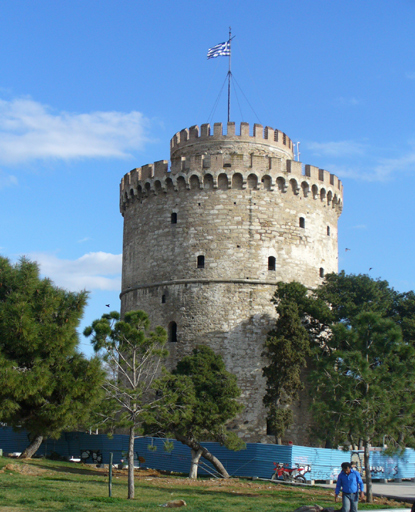 The present White Tower dates from the reign of the Ottoman Sultan Suleiman the Magnificent (1520–66)It was originally incorporated into the ramparts that surrounded the city and was the main defensive element in the section fronting the sea. During a massacre of rebellious Sultan guards in 1826, the building became known as the Bloody Tower, an unwelcome title which the Turks decided to suppress by whitewashing the walls and renaming it the White Tower.
The present White Tower dates from the reign of the Ottoman Sultan Suleiman the Magnificent (1520–66)It was originally incorporated into the ramparts that surrounded the city and was the main defensive element in the section fronting the sea. During a massacre of rebellious Sultan guards in 1826, the building became known as the Bloody Tower, an unwelcome title which the Turks decided to suppress by whitewashing the walls and renaming it the White Tower.
 It was a pleasant day for walking along the waterfront and seeing the sights.
It was a pleasant day for walking along the waterfront and seeing the sights.
 In the other direction we saw the contrast of the many hotels and residences on the waterfront.
In the other direction we saw the contrast of the many hotels and residences on the waterfront.
 The next morning on our way to Philippi, we saw more of the ancient walls of the upper city.
The next morning on our way to Philippi, we saw more of the ancient walls of the upper city.
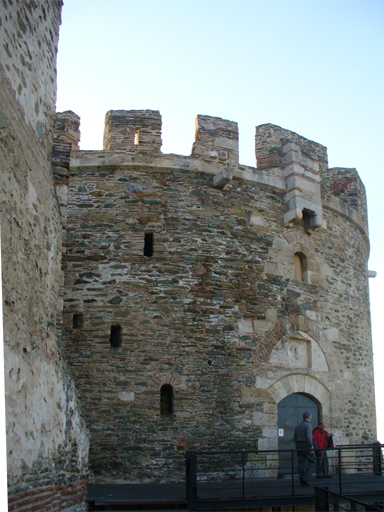 A tower in the old walls.
A tower in the old walls.
 From here we had a great view of the city below with Mt. Olympus in the distance.
From here we had a great view of the city below with Mt. Olympus in the distance.
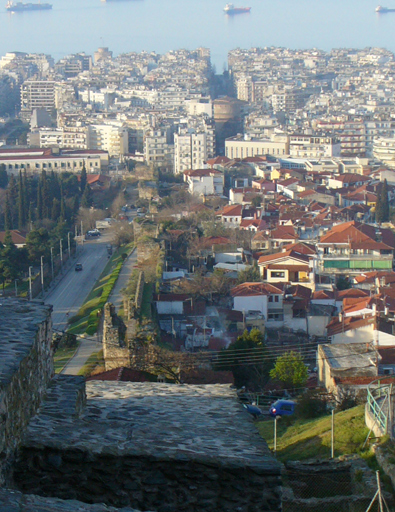 A telephoto shot clearly shows the remains of the wall on the left, the Rotunda of Galerius in the center and the White Tower at the upper left.
A telephoto shot clearly shows the remains of the wall on the left, the Rotunda of Galerius in the center and the White Tower at the upper left.
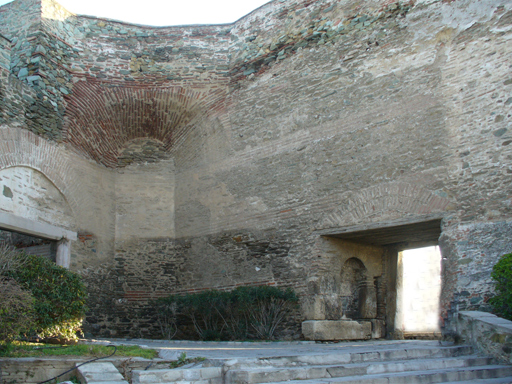 A highlight for us was the Great Gate. Our guide, Costas, told us the opening on the right led to the Via Egnatia, the road Paul would have traveled when he came from Philippi to Thessalonica. So it may have been that in going through that gate, we were literally walking in the footsteps of Paul.
A highlight for us was the Great Gate. Our guide, Costas, told us the opening on the right led to the Via Egnatia, the road Paul would have traveled when he came from Philippi to Thessalonica. So it may have been that in going through that gate, we were literally walking in the footsteps of Paul.
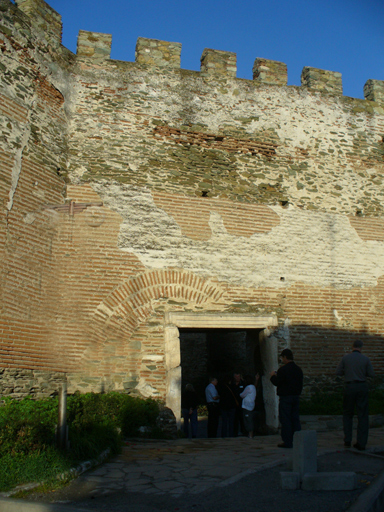 A view of this gate from the other side.
A view of this gate from the other side.
 On our return from Philippi later in the day, we stopped at the Roman Forum in the center of Thessalonica. Parts of it are from the 2nd century BC and other parts as late as the 2nd century AD.
On our return from Philippi later in the day, we stopped at the Roman Forum in the center of Thessalonica. Parts of it are from the 2nd century BC and other parts as late as the 2nd century AD.
 This is the 2nd century AD odeon, used for musical performances, which seated about 400 people. To the left are the remains of official goverment buildings.
This is the 2nd century AD odeon, used for musical performances, which seated about 400 people. To the left are the remains of official goverment buildings.
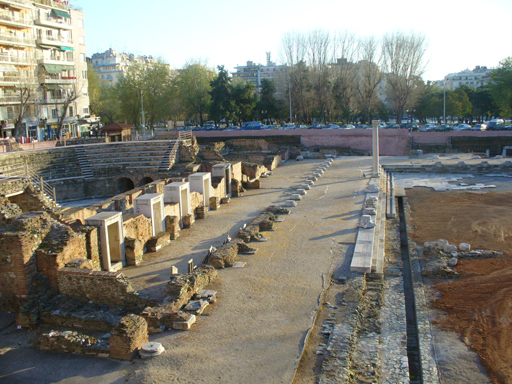 There was a stoa (porch) with colonnades.
There was a stoa (porch) with colonnades.
 This was an older section and part of a Roman bath.
This was an older section and part of a Roman bath.
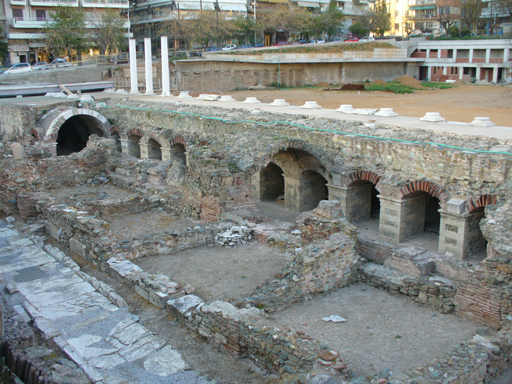 A section of shops.
A section of shops.
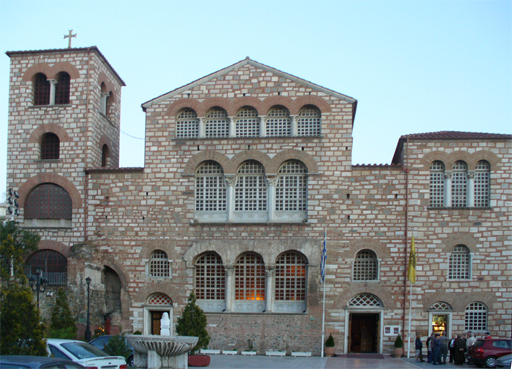 Nearby was the Agios Dimitrios, the church dedicated to St. Dimitrius, the patron saint of Thessalonica martyred by Galerius. The basilica was built in the 5th century but gutted by fired in 1917. It was reconstructed from the original materials, so far as possible, between 1926 and 1948.
Nearby was the Agios Dimitrios, the church dedicated to St. Dimitrius, the patron saint of Thessalonica martyred by Galerius. The basilica was built in the 5th century but gutted by fired in 1917. It was reconstructed from the original materials, so far as possible, between 1926 and 1948.
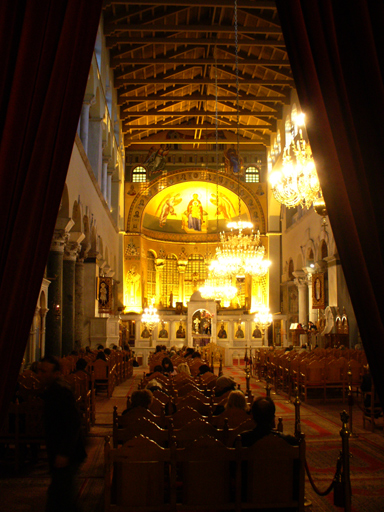 A mass was taking place, but we were able to see the interior as well.
A mass was taking place, but we were able to see the interior as well.
 We were able to get a view of the chancel area and a few of its many icons.
We were able to get a view of the chancel area and a few of its many icons.
 This is an icon of St. Demetrius.
This is an icon of St. Demetrius.
The next page tells about our day in Philippi.
